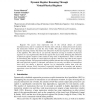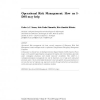352 search results - page 26 / 71 » Quantifying Instruction Criticality |
MICRO
2000
IEEE
14 years 3 months ago
2000
IEEE
Value prediction breaks data dependencies in a program thereby creating instruction level parallelism that can increase program performance. Hardware based value prediction techni...
JILP
2000
13 years 10 months ago
2000
Register file access time represents one of the critical delays of current microprocessors, and it is expected to become more critical as future processors increase the instructio...
JDS
2007
13 years 10 months ago
2007
Operational Risk management, the least covered component of Enterprise Wide Risk Management, needs intelligent tools to implement Comprehensive Emergency Management Programs. In t...
DATE
2003
IEEE
14 years 4 months ago
2003
IEEE
Smart cards are vulnerable to both invasive and non-invasive attacks. Specifically, non-invasive attacks using power and timing measurements to extract the cryptographic key has d...
PPOPP
2009
ACM
14 years 11 months ago
2009
ACM
Load balancing is a technique which allows efficient parallelization of irregular workloads, and a key component of many applications and parallelizing runtimes. Work-stealing is ...


